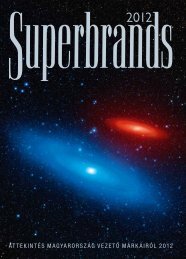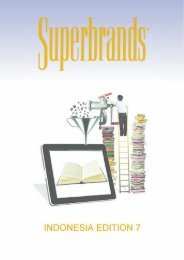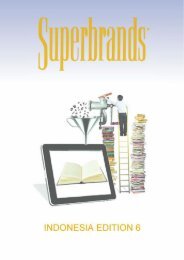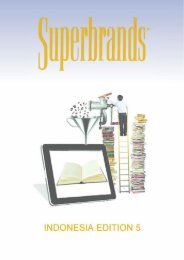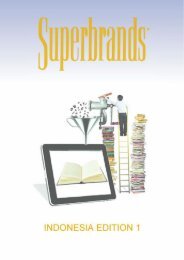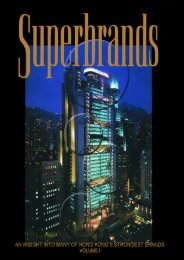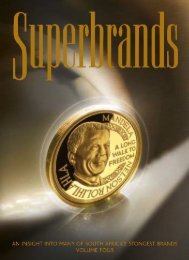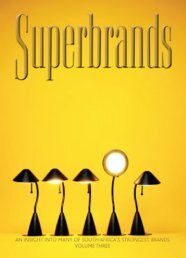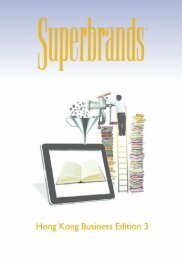South Africa Edition 2
You also want an ePaper? Increase the reach of your titles
YUMPU automatically turns print PDFs into web optimized ePapers that Google loves.
THE MARKET<br />
German-born Opel builds cars that combine classic<br />
body styles with rugged and durable mechanical<br />
design. Opel is all about questioning conventions<br />
and treading new paths. It’s a brand with a strong<br />
personality, embodied in vehicles driven by people<br />
of similar charisma. It offers excellent value for<br />
money and the promise of Opel’s superb backup<br />
service.<br />
Opel has been manufacturing cars in Europe<br />
since 1898. The brand’s market in Europe<br />
accounts for 78 percent of holding company<br />
General Motor’s European sales. In 2006, Opel<br />
was ranked as the fourth most-registered vehicle<br />
make in Europe, where 1,563,196 Opel vehicles<br />
were sold, giving Opel a market share of 7.2<br />
percent.<br />
Opel’s parent company in <strong>South</strong> <strong>Africa</strong>,<br />
General Motors SA, currently assembles Opel<br />
and Isuzu vehicles at its production facility in<br />
Port Elizabeth. Opel has a seven percent share of<br />
the <strong>South</strong> <strong>Africa</strong>n vehicle market,<br />
while GM’s market share grew<br />
by 1.4 percent last year to 13.6<br />
percent. Sales were up 40 percent,<br />
compared to an industry average of<br />
26 percent.<br />
Opel is a brand that moves<br />
<strong>South</strong> <strong>Africa</strong>ns, with a full range of<br />
vehicles catering for most segments<br />
of the local market.<br />
ACHIEVEMENTS<br />
Local: In 2007, the Opel Astra<br />
GTC 1.9 CDTi was nominated as a<br />
2006 Car of the Year Finalist. In July<br />
2007, GM retained leadership of the<br />
“sub-1-ton” segment with the Opel Corsa Utility<br />
for a 26th consecutive month. In August 2007,<br />
Associated Magazines’ popular Women on Wheels<br />
(WOW) supplement selected Opel as finalists in<br />
two categories of the Women’s Car of the Year<br />
Awards:<br />
• Best Car for Women under<br />
R100 000 - Opel Corsa Lite<br />
• Best Car for Women between<br />
R100,000 and R200,000 -<br />
Opel Tigra<br />
International: In January<br />
2007, Opel’s new Corsa was<br />
named “Car of the Year 2007”<br />
and “Best Supermini” by the<br />
renowned British consumer<br />
magazine What Car? The<br />
Corsa beat 14 category winners<br />
to take the top honours, adding<br />
to its rapidly growing list of<br />
European awards.<br />
HISTORY<br />
The Opel brand’s history began with a sewing<br />
machine designed by Adam Opel in 1862. When<br />
the founder died in 1895, Opel’s company was not<br />
only leading European sewing machine sales, but<br />
also producing over 2,000 bicycles annually.<br />
Opel shifted its focus from sewing machines<br />
to cars in 1898. Adam Opel’s sons managed<br />
the company and acquired car manufacturer<br />
Lutzmann. As a result, the cars produced initially<br />
by Opel were distributed under the brand name<br />
Opel-Lutzmann. For economic<br />
reasons, the partnership only<br />
lasted two years.<br />
In 1900, Opel entered into<br />
a partnership arrangement with<br />
French company Automobiles<br />
Darracq SA. The models<br />
produced by the company were<br />
called Opel-Darracq. The cars<br />
had a Darracq chassis integrated<br />
and installed into Opel car<br />
bodies. Opel-Darracq models<br />
were developed and unveiled<br />
in 1902, but it was only in 1906 that the brand<br />
started marketing its cars. Opel-Darracq grew to<br />
become the biggest German car manufacturer by<br />
1913.<br />
Opel’s partnership with General Motors began<br />
way back in 1929. At that time, the US-based<br />
GM had accumulated an 80 percent stake in<br />
Opel-Darracq. Adhering to takeover rules,<br />
GM bought 100 percent of Opel from the<br />
Opel family for a reported $33.3 million.<br />
From then on, Opel dropped the Darracq<br />
name and became a GM subsidiary and inhouse<br />
brand known simply as Opel.<br />
By 1936, with an annual production of<br />
120,923 vehicles, Opel was Europe’s largest<br />
car manufacturer. Growing steadily over<br />
the years, Opel branched out to different<br />
countries to set up operations. In 1982, the<br />
company built a new plant in Zaragoza,<br />
Spain, specifically for the production of<br />
the Opel Corsa - the most compact car ever<br />
produced by Opel.<br />
There were celebrations in 1983 as the 20-<br />
millionth Opel left the Rüsselsheim plant.<br />
In 1985 Opel became the first vehicle<br />
manufacturer to offer a complete range of models<br />
equipped with catalytic converters. The brand<br />
also developed a global sponsorship concept<br />
which formed the basis of a strong engagement<br />
in dynamic ball sports and partnerships with<br />
world-class athletes and teams, in keeping with<br />
its strong inclination towards “sporty” design.<br />
1987 brought celebrations of the 125th<br />
anniversary of Opel, and in 1994 Opel produced<br />
its 30-millionth vehicle.<br />
In 2002, the Corsa - the world’s most<br />
successful small car - celebrated its 20th birthday<br />
and a production record of 11 million units were<br />
produced since the first one was delivered in<br />
September 1982.<br />
In 2003, Opel distributors around the world<br />
began redefining the Opel brand to embrace





